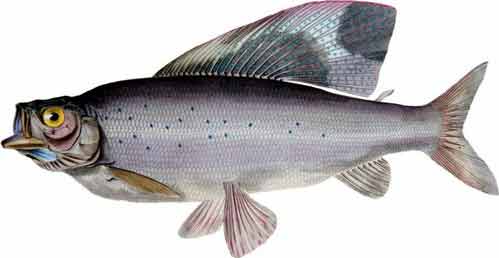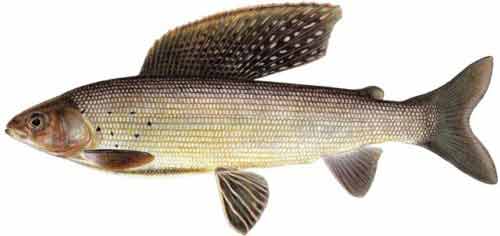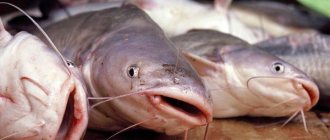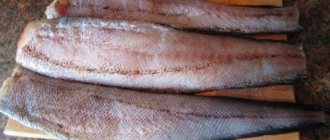Calorie content of Grayling. Chemical composition and nutritional value.
Nutritional value and chemical composition of “Greyling”.
| Nutrient | Quantity | Norm** | % of the norm in 100 g | % of the norm in 100 kcal | 100% normal |
| Calorie content | 112 kcal | 1684 kcal | 6.7% | 6% | 1504 g |
| Squirrels | 20.6 g | 76 g | 27.1% | 24.2% | 369 g |
| Fats | 3.3 g | 56 g | 5.9% | 5.3% | 1697 g |
| Water | 74.8 g | 2273 g | 3.3% | 2.9% | 3039 g |
| Ash | 1.3 g | ||||
| Macronutrients | |||||
| Sera, S | 206 mg | 1000 mg | 20.6% | 18.4% | 485 g |
| Phosphorus, Ph | 200 mg | 800 mg | 25% | 22.3% | 400 g |
The energy value of Grayling is 112 kcal.
Main source: Skurikhin I.M. and others. Chemical composition of food products. Read more.
** This table shows the average levels of vitamins and minerals for an adult. If you want to know the norms taking into account your gender, age and other factors, then use the “My Healthy Diet” application.
Product calculator
| Contents per serving | % of normal | ||
| Calories | 112 kcal | -% | |
| Squirrels | 20.6 g | -% | |
| Carbohydrates | 0 g | -% | |
| Alimentary fiber | 0 g | -% | |
| Water | 74.8 g | -% | |
Product calorie analysis
Ratio of proteins, fats and carbohydrates:
Types and varieties
Valuable fish from the grayling family are represented by three main species and several dozen subspecies. Chilled/frozen grayling arrives in the retail chain and on the table of delicacy connoisseurs: • European
– fishing is carried out on the territory of Russia and Finland in rivers that are part of the Arctic Ocean basin;
• Mongolian
– lives in flowing water bodies of eastern Siberia, northern China and Mongolia;
• Siberian
(
has the largest number of subspecies
) – its habitat is all the rivers of Siberia: Lena and Ob, Amur and Irtysh, Amur and Yenisei.
Frozen grayling carcasses or steaks are most often sold. In specialized stores during the period of mass fishing, live ( fresh)
) fish or gutted chilled carcasses.
The weight of each carcass, depending on the type/subspecies and age of the fish, varies between 0.7-1.5 kg. Very often there are valuable representatives of grayling weighing up to 2.5 kg. In the 90s of the last century, a real “giant” was caught in Lake Ladoga - European grayling weighing 5.2 kg and 87 cm long.
Why is Grayling useful?
- Phosphorus
takes part in many physiological processes, including energy metabolism, regulates acid-base balance, is part of phospholipids, nucleotides and nucleic acids, and is necessary for the mineralization of bones and teeth. Deficiency leads to anorexia, anemia, and rickets.
You can see a complete guide to the healthiest foods in the “My Healthy Diet” app.
- home
- Product composition
- Composition fish and seafood
- Chemical composition of “Greyling”
Tags:
Grayling calorie content 112 kcal, chemical composition, nutritional value, vitamins, minerals, how Grayling is useful, calories, nutrients, beneficial properties of Grayling
Energy value, or calorie content
- this is the amount of energy released in the human body from food during the digestion process. The energy value of the product is measured in kilocalories (kcal) or kilojoules (kJ) per 100 grams. product. The kilocalorie used to measure the energy value of food is also called a food calorie, so when caloric content is reported in (kilo)calories, the prefix kilo is often omitted. You can see detailed energy value tables for Russian products here.
The nutritional value
— content of carbohydrates, fats and proteins in the product.
Nutritional value of food product
- a set of properties of a food product, in the presence of which the physiological needs of a person for the necessary substances and energy are satisfied.
Vitamins
, organic substances required in small quantities in the diet of both humans and most vertebrates. Vitamin synthesis is usually carried out by plants, not animals. A person's daily requirement for vitamins is only a few milligrams or micrograms. Unlike inorganic substances, vitamins are destroyed by strong heat. Many vitamins are unstable and are “lost” during cooking or food processing.
Varieties of grayling
Graylings inhabit many reservoirs of the Holarctic, descending into rivers and lakes as far as France and Italy, Altai and Mongolia. In the southern regions of their range they inhabit only mountain streams and rivers, reminiscent of their demands on water. In the north, rivers and lakes, taiga streams and shallow channels are more widespread and inhabited.
The following types of grayling are distinguished:
- common - common in the European part of the Eurasian continent, but its representatives live and spawn in Siberia, in the Ob basin;
- Siberian - has many subspecies, found from the Urals to the Far East, the identity of the forms of Canadian and Siberian representatives is recognized;
- Mongolian - in rivers and lakes in the southern part of Eastern Siberia and on Mongolian territory;
- Some subspecies of Siberian grayling are distinguished into separate species (Upper Yisei, Tugarin, Yalu, Khubsugul).
The differences are not only in color. Scientists believe that the original form of all varieties is Mongolian grayling. It is more primitive in structure and does not have a long dorsal fin. The teeth of this variety are more developed; there are also sections of the dental apparatus that were reduced in Siberian and European forms. The subspecies of grayling from Lake Baikal (black and white Baikal) are endemic and are not found anywhere else.
Grayling - benefits and harm
Grayling is a fish of the salmon family. This fish is easily recognized by its characteristic large fin located on its back. It also has a memorable coloring and is considered a very beautiful fish. Although its body color may be inconspicuous - grayling has a dark gray color, what makes it interesting and attractive are its black spots, which have asymmetry and are located over the entire surface of the body.
There are several species of grayling, some of which are distinguished by a red spot that is located above the ventral fins. Depending on the subspecies, the additional colors in which the fish is painted may be different. On the red fins of the fish, spots can be red, purple and turquoise.
The size of grayling is not very large, but some individuals can reach a weight of 5 or 6 kg. You can also find dwarf graylings.
Most of all, these fish love cool and always clean water. Grayling is a predatory fish and can eat the larvae of various insects and the adults themselves. But large graylings can even eat other smaller fish.
Properties of grayling
This fish is not only very beautiful, but also quite tasty. Its fillet is distinguished by its tenderness, but at the same time, during processing it does not fall into pieces, but retains its elasticity.
Grayling is often included in diet food because it has a low calorie content. It contains about 90 kcal (per 100 g), and if the fish is not fried or dried, but steamed or boiled, then it can easily replace meat products during the diet.
Unlike many species of fish, grayling does not smell like mud, but like fresh cucumber, which is its distinctive feature.
Benefits of grayling
Grayling is excellent for the diet due to its low calorie content. But despite the fact that there are few calories in it, the meat is soft and juicy. This fish contains a sufficient amount of protein (17.5 g), while there is only 2 g of fat and 0 carbohydrates.
Among the vitamins, this fish contains PP, and among the minerals, fluorine, sulfur, chromium, nickel, and molybdenum.
Use of grayling
You can purchase fresh grayling (frozen or chilled) at any large grocery store. Any dish can be prepared from this fish. It all depends on the imagination of the cook. Grayling does not have the smell of mud, which is characteristic of many types of other fish, so there are no restrictions in cooking.
The simplest way to cook fish is fish soup. Interestingly, those parts of the fish’s body that are usually not used in cooking can be used here: the head, fins, entrails and spine. Based on them, you can make a broth in which the fish will be cooked in the future. And although the meat is elastic, it is important not to overcook the grayling.
In addition to grayling fish soup, you can prepare other dishes of varying complexity. So, this fish can be baked, salted, fried, smoked and marinated.
But no matter what cooking method is chosen, it is important to observe the temperature and cooking time. As mentioned earlier, grayling does not tolerate unnecessary heat treatment. If you do not follow this rule, tender and juicy meat can easily turn into dry and tough.
Boiled and steamed fish can be included in the diet by replacing meat products.
Damage to grayling
This fish is harmless to people and is recommended for consumption by everyone. It cannot be eaten in only one case - with individual intolerance.
However, it is worth noting that grayling prepared by salting, drying or frying will be considered a high-calorie product, and can aggravate various chronic diseases due to the high salt and oil content.
Video
Grayling diet
This fish, called a predator, is actually an omnivore. The main diet consists of insects - midges, cicadas, grasshoppers, flies, gadflies and any others who had the temerity to fly close to the water.
In addition to insects, grayling feed on benthic trifles - gammarus crustaceans, caddis flies, mollusks, mayflies, etc. He likes the caviar of other fish. If there is none of this, he will eat algae.
How much does grayling fish cost (average price per 1 kg)?
Moscow and Moscow region.
Grayling fish is one of the most attractive representatives of freshwater bodies of water that can be found on the territory of the Russian Federation. Although it is not particularly large in size, its unusually attractive color makes the grayling fish one of the most colorful waterfowl.
A distinctive component of the extraordinary beauty of the grayling fish is its large dorsal fin, painted with a multi-colored pattern, which is often called a sail. In addition, the entire body of the fish is covered with small scales, which shimmer in the rays of sunlight with all the colors of the rainbow.
The grayling fish is a close relative of fish from the whitefish and salmon families. Accordingly, it can be caught exclusively in fast-flowing cold rivers of northeastern and northern Russia, as well as throughout Siberia.
It is noteworthy that not only the attractive appearance, but also the gastronomic properties of grayling are highly valued. In fact, this is an unusually tender fish, which is distinguished by elastic, white-pink, very pleasant-tasting meat. In addition, the low calorie content of grayling allows this fish to be used in dietary nutrition.
Meanwhile, grayling fish produces excellent fish soup, which is distinguished by its excellent taste and transparency. In addition, grayling is often fried or salted. The latter option is especially typical for the summer season, when immediately after catching the fish, they gut it, sprinkle it with salt, and then cover it with sedge or nettles for better preservation. For people who are not keen on fishing, frozen or chilled grayling is available for sale, which often comes in gutted form.
Smoked grayling is considered very tasty, which you can not only buy in the store, but also cook yourself. For this, a smoking chamber is used, in the absence of which you can resort to the help of a special smoking liquid - the so-called liquid smoke.
In fishing cuisine there is a considerable list of delicious dishes that are prepared from grayling fish: this fish is not only pickled, salted or fried, but also made into unusual dishes. For example, a dish called heh. Essentially, you get finely chopped grayling fish fillets, which are marinated for a short time in vinegar, salt and pepper. Heh, made from grayling, is a fairly simple, but less tasty and appetizing fish appetizer that can add variety to your menu and help out many times over.
In principle, grayling fish can be cooked like any other fish. The only condition for a tasty dish is that the cooking time must be reduced so that the fish does not dry out and become tough. And another property of grayling, which only adds to its advantages, is the complete absence of a specific fishy smell - it smells fragrant with the aroma of fresh cucumber.
Grayling fish – product description with photos, calorie content; how to catch and cook; benefit and harm
Grayling fish: properties
Calorie content: 88 kcal.
Energy value of the product Grayling fish: Proteins: 17.5 g. Fats: 2 g. Carbohydrates: 0 g.
Description
Grayling fish belongs to the salmon family, although it has quite significant external differences from other individuals belonging to this family. Grayling has an oblong large body and a marbled silver color, which can be diluted with black spots. Adult fish are darker in color.
The size of grayling fish can reach half a meter in length, and the weight does not exceed two kilograms. The lifespan of individuals is up to ten years.
Grayling is a river fish. She prefers cool water for comfortable living. Also, like the entire salmon family, this fish is very sensitive to pollution and oxygen levels in the water. Because of this, the main habitat of grayling is mountain rivers and lakes with clean and cold water.
This type of fish does not welcome abundant vegetation, so grayling cannot be found in reservoirs with a lot of silt and algae.
There are three types of fish:
They all differ in color, size, habits and habitat.
Grayling usually spawns in late spring or early summer, when the water temperature in its habitat rises to ten degrees.
Grayling is a predatory fish, so as adults it feeds on insects that fall into the water, and can also eat small mammals. It often attacks large fish and feeds on fry. At a young age, it eats mollusks, larvae and small crustaceans.
In the food industry, grayling fish is used to prepare delicious snacks, first courses, side dishes, etc. If you are planning to go fishing to catch these fish, we recommend that you read the next section.
How to catch?
The best time to fish for grayling is from the beginning of June until ice appears on the rivers. In winter, fishing for this fish will not bring results, since grayling is practically not active at this time of year.
This type of fish does not really like the sun, so in sunny weather it goes deeper. It is better to catch it at sunset, before sunrise, at night or in cloudy weather. In this case, you can use any type of fishing rod, but it is important to know that grayling likes to stay away from the shore. You will need a boat or casting rod.
The best bait to catch this fish is:
- bloodworm;
- worm;
- pieces of other fish;
- fry;
- cockroaches;
- grasshoppers;
- larvae of large insects.
It is also advisable to know that bait should not be used to catch grayling. It will be enough to arm yourself with a long stick and muddy the waters. Then you can cast a baited hook and wait.
How to cook grayling fish?
You can prepare grayling fish at home in a large number of different ways. It doesn’t matter whether you caught it yourself or bought it in a store. Wash it first and leave it to dry.
An important point: it is better to cook fish when it is still fresh, since after defrosting, grayling may lose some of its taste.
Most housewives prefer to bake grayling in the oven under various sauces, adding certain ingredients. Alternatively, you can bake it with onions, tomatoes and other vegetables, as well as in its own juice. In addition, you can salt or smoke this fish. Salt it as follows:
- Prepare the necessary ingredients, namely: grayling fish, onions, vinegar, sunflower oil, lemon and salt and pepper to taste.
- The fish must be washed and giblets removed, and the tail and head must be trimmed. After this, the product should be cut into equal pieces.
- Place the chopped grayling in a deep bowl and add salt and pepper. You can also add any other spices to your taste. Mix the contents of the bowl and leave to infuse for half an hour.
- Dilute the vinegar with water so that it gives the dish a slight sourness, but does not interrupt its main taste.
- Peel and cut the onion into half rings, add to the bowl with the fish, where you also add the lemon. Pour it all with sunflower oil and leave to steep for half an hour or forty minutes, after which the dish will be ready to eat.
Another great option for preparing grayling is to make fish soup out of it. Also, many fishermen prepare delicious shish kebab from their fresh catch while fishing.
This fish has very tender meat and does not have many bones. It can be fried in a frying pan or stuffed with vegetables. In addition, “He” made from red grayling meat is a popular dish.
You can find a large number of various recipes that will help you prepare a delicious dish from this fish. The main thing is that it must be fresh. And then you just need to use your imagination and stock up on the necessary products.
Benefits and harms
Any product can cause benefit or harm, including grayling fish. Especially if you do not take into account contraindications, which include individual intolerance to fish, as well as acute gastritis. It is especially not recommended to eat baked or fried grayling for people who have stomach problems.
As for the beneficial properties of this fish, they include the following:
- since grayling meat can be considered low-calorie, it is recommended for people who are on a diet;
- Fish contains a large amount of vitamins and microelements that have a beneficial effect on the immune system and also supply the body with necessary mineral components;
- Regular consumption of grayling has a positive effect on the functioning of the thyroid gland, providing the body with iodine.
Remember that you should not get carried away with eating fish, as this can harm your body.
Calorie content of grayling fish 88 kcal
Energy value of grayling fish (Ratio of proteins, fats, carbohydrates - bzhu):
: 17.5 g (~70 kcal) : 2 g (~18 kcal) : 0 g (~0 kcal)
Grayling is an omnivorous fish that is distinguished by its caution and difficulty in catching. Many fishermen hunt for it, but only a fraction of them succeed in catching large specimens. Grayling is the prey of a fisherman who carefully selects tackle and bait. Sometimes it gets hooked by accident as by-catch for trout, but this happens rarely.
Grayling: photo, preparation, benefits and harm
Grayling: description, composition, preparation, composition, benefits and harm
Grayling (lat. Thymallus) is a small genus of fish (there are 7 species) belonging to the Salmonidae family and the Salmonidae order. The Latin name of the genus is of ancient Greek origin and means “unknown freshwater fish.” As for the Russian-language name, it appears to be of Baltic-Finnish origin. The Finns call this fish the same as we do – harjus.
Grayling is a valuable object for sport and recreational fishing. The best gear for this is fishing rods with a fly, but in some reservoirs even ordinary float gear with earthworm bait performs well. A large grayling takes a lure (using a spinning rod).
Description of grayling
A characteristic feature of all graylings is the presence of a large dorsal fin. In some adult males it sometimes reaches the base of the caudal fin. The size of the dorsal fin itself varies depending on the species.
The fish has a very beautiful color. Graylings have a dark gray back; some species have black spots on their sides, the shape of which can also be used to determine the type of fish. A number of species (Siberian, Amur, Lower Amur, Baikal and yellow-spotted) have a rather large reddish spot above the ventral fins. On the ventral fins, oblique red-brown stripes are visible, which are distinguished by a purple tint. Adult graylings have red-burgundy anal and caudal fins. It is also characteristic that in males the dorsal fin becomes higher as it moves towards the tail, while in females the dorsal fin remains the same height throughout. On the dorsal fin, rows of reddish horizontal spots are clearly visible, as well as vertical stripes of turquoise or purple shades of round or elongated shape.
The size of grayling depends on the species. The largest graylings are European and Mongolian (up to 5-6 kg). At the same time, in some Siberian lakes located in high mountain regions, dwarf forms of grayling live, which throughout their lives retain the color of the fry, that is, the sides of their bodies are covered with dark transverse stripes.
Grayling lifestyle
Grayling lives in fast-flowing rivers that are fed from mountain glaciers or cold springs, as well as in high-mountain lakes at altitudes up to 200-2300 m above sea level.
Graylings feed mainly on zoobenthos - larvae of caddisflies, mayflies, stoneflies, chironomids, and some adult insects. In the warm season, the food of graylings can be flying insects (mosquitoes, flies, horseflies, gadflies, dragonflies, etc.), to catch which they can even jump out of the water. Adults of some grayling species lead a predatory lifestyle, eating other fish and sometimes small rodents.
The most popular types of grayling are European and Siberian

European grayling (lat. Thymallus thymallus)
Nomenclatural (type) species of the genus. Distribution area: rivers, streams and lakes of Europe - from Great Britain and France to the Ural Range. Prefers cold water.
The fish is medium in size, can reach a length of 60 cm and weigh up to 6.7 kg. The pectoral fins are gray in color and lack red spots. The dorsal fin is grayish in color, covered with parallel rows of dark rounded dots.
The diet includes small crustaceans, spiders, insects, shellfish and small fish (minnows).
European grayling is listed in the Red Book of Russia, Ukraine, Belarus, Germany, as well as a number of regions of the Russian Federation (Yaroslavl, Kirov and Chelyabinsk regions).
Lives up to 14 years.

Siberian grayling (lat. Thymallus arcticus)
In many ways it is similar to its European relative. But it differs from the latter in its larger mouth and more noticeable teeth.
Their color is very similar, but in large rivers Siberian grayling is lighter than European grayling, and in taiga rivulets and streams it is darker than European grayling.
In some reservoirs of Russia, both types of grayling live - European and Siberian (for example, the Kara River basin in Siberia).
The Siberian grayling has 7 subspecies (West Siberian, black and white Baikal, Amur, Kamchatka, East Siberian, Alaskan).

Grayling in cooking
Grayling belongs to the salmon family, and this says a lot. Although its meat is white, its taste is in no way inferior to the “Red Army” salmon. It is just as juicy and tender in taste with low fat content. Despite the fact that grayling is a resident of freshwater bodies, its meat never smells like mud. Very often it has a faint smell of fresh cucumber.
Grayling cannot be bought in stores, because its industrial harvesting is difficult due to the fishing method, and it is under special protection as an endangered species, and breeding it in aquaculture is troublesome and unprofitable.
Grayling can be prepared in a variety of ways. The choice of recipe depends not least on the size of the fish. If it is small, then after gutting and cleaning it, you can simply salt it and then eat it with the bones. Small grayling makes a very tasty fish soup. Large specimens do not hamper the cook so much in choosing a cooking method; they can also be salted or put on fish soup, but nothing prevents them from being baked, fried, stewed, or used as a filling for pies.
When preparing grayling, there is one caveat: it cannot be subjected to prolonged heat treatment, otherwise the fish will not only become tough and dry, but will also lose its taste. It is difficult to give general recipes for all cases and methods of preparing grayling, because much depends on the size of the fish. For example, in an ear with pieces the size of a matchbox, it is boiled for no more than 8 minutes. In short, everything requires experience and intuition.
Composition of grayling (per 100 g)
| The nutritional value | |
| Calorie content, kcal | 112 |
| Proteins, g | 20,6 |
| Fats | 3,3 |
| Water, g | 74,8 |
| Ash, g | 1,3 |
| Macronutrients | |
| Phosphorus, mg | 200 |
| Sulfur, mg | 206 |
| Chlorine, mg | 165 |
| Microelements | |
| Zinc, mg | 0,7 |
| Molybdenum, mcg | 4 |
| Nickel, µg | 6 |
| Fluorine, mcg | 430 |
| Chromium, µg | 55 |
Useful properties of grayling
Grayling is a useful fish in many respects. Nowadays, when the environmental situation in almost all corners of the globe is simply appalling, it is not so much the benefits of a food product that are of particular importance, but the absence of harm from it. So, grayling clearly wins in this regard. It is found only in bodies of clean water - forest and mountain rivers, streams and lakes fed by underground springs and glaciers, so it does not contain toxic substances.
But the benefits of grayling are also obvious. This fish is low in calories and very rich in protein. That is, the product is the most dietary. Grayling is indicated in baby food, nutrition for pregnant and lactating women, athletes, the elderly, people with poor health, and overweight. In general, to all those who care about their own health.
Grayling meat contains a lot of phosphorus, which strengthens our bones and teeth and improves brain activity. Regarding dental health, I also ask you to pay attention to the high fluorine content in grayling meat.
Zinc, present in grayling in fairly decent quantities, enhances male potency by normalizing hormonal levels.
Damage to grayling
Grayling is a harmless fish. You should not overuse salted grayling, especially in case of diseases of the cardiovascular system (hypertension), kidneys and in case of exacerbation of diseases of the gastrointestinal tract (gastric and duodenal ulcers, hepatitis, cholecystitis).
Individual intolerance to the product is possible.
Description of grayling
This beautiful fish does not resemble anything in appearance, although it belongs to the same family
. Many experts give grayling primacy in beauty among all salmon fish.
Appearance
Graylings are easily distinguished from other fish, even their closest relatives, by a characteristic feature - a large dorsal fin, similar to a flag or fan, which can fold and reach almost to the caudal fin. This "flag" is covered in spots, like the upper back.
Fish size
differs significantly depending on the conditions in which it grew:
- what are the features of the reservoir;
- saturation of water with oxygen,
- vast food supply;
- light mode;
- water temperature, etc.
In not very favorable conditions, graylings become smaller and weigh barely a kilogram at the adult age of 7 years (Transbaikal grayling). In good places, the weight reaches 5-6 kg (for European and Mongolian grayling). Average values are about 3-4 kg. The body length of the fish is about 30 cm, especially large specimens reach half a meter in length.
This is interesting!
Features of the habitat affect not only the size and weight, but also the color of the grayling, and even the nuances of the body structure.
Body
Grayling has a strong, streamlined body, which makes it possible to glide in fast river waters. It is covered with large, adjacent scales of various colors. On the back there is a fan-shaped large dorsal fin, as well as another characteristic feature - a small adipose fin, a sign of “noble” salmon origin. There are pelvic and pectoral fins, a caudal and anal.
Mouth
small in size, the so-called “upper”, that is, opens towards the surface of the water. The teeth are weak, located in a barely noticeable “brush”.
Grayling coloration
gained him the reputation of a beautiful and elegant fish. The dark gray tone of the back is diluted with small black spots that extend onto the dorsal fin. The sides are light silver, the belly is grayish.
This is interesting!
Scientists have identified about 40 varieties of the large dorsal fin of grayling, differing in shape, size, color, and pattern of spots and stripes.
The fins are dark in color, sometimes they are purple (tail) or yellowish (abdominal and pectoral). The body color can be varied; graylings are found in different places:
- brownish;
- with a lilac tint;
- spotted;
- bluish-gray;
- greenish.
Such beautiful coloring helps grayling to camouflage and survive in various situations. It looks even more attractive and brighter during the spawning period. Young slaves have a “fry” coloration - with a transverse dark stripe. Some species retain it into adulthood, usually these are dwarf varieties that live in mountain lakes at high altitudes.
Behavior and lifestyle
Grayling is a “homebody” among fish; it leads a sedentary lifestyle and does not sail further than 10-30 km from its underwater grounds. This is the reason for the diversity of species - fish in one part of the reservoir only interbreed with each other. The only exception is the spawning period for graylings living in fast rivers: in the spring the fish go to the sources and rise into the tributaries with spring floods, and return back for the winter.
This sedentarism also explains the differences in the habits of different grayling populations. Lake specimens fatten without leaving their habitats, while river specimens go to the upper reaches of the river to spawn.
Important!
The fish is not a schooling fish; it only gathers “in company” during spawning.
Lifestyle
dictates the nature of the predator. Graylings are very sensitive, attentive to the slightest changes: a shadow falling on the water, the reflection of a fisherman or even a fishing rod, movement near the water and in the water. Having sensed a possible danger, the fish quickly hides for cover.
Having hunted in the morning, grayling fills its stomach, and during the day it only picks up especially tasty midges from the surface of the water - this is called “melting”. During the daytime it hides mostly at depth and in shelters - algae, stones, gullies. Sometimes grayling “plays” by jumping out of the water and turning 360 degrees in the air, doing somersaults and flips. This is how a strong body trains to survive in fast waters.
Lifespan
Grayling lives for about 14 years and is ready to spawn at 3-5 years of age.
Types of grayling
Graylings are divided into species based on appearance. Since it directly depends on the habitat, the species received the names of the corresponding areas.
There are three main types of grayling with many subspecies.
Mongolian grayling
- the largest of the grayling family.
European grayling
– with the brightest colors and a large dorsal fin.
Siberian grayling
– he has the largest mouth, the color is darker, the color of paired fins is orange, unpaired fins are deep purple, there is a reddish spot on the chest. It has many varieties, differing in habitat, color and nuances of the large dorsal fin:
- West Siberian subspecies - has a shortened, wide dorsal fin, metallic, with large spots;
- East Siberian subspecies - the fin is very large, when folded it almost reaches the tail, between its rays there are dark red lines;
- Kamchatka subspecies - densely spotted, the spots are almost connected, it has a very large head and mouth;
- Alaskan subspecies - the fin is smaller, the pattern of spots on it is arranged in rows;
- Amur subspecies - on the pelvic fins - oblique red stripes with a purple tint;
- Baikal white and black and other varieties.










